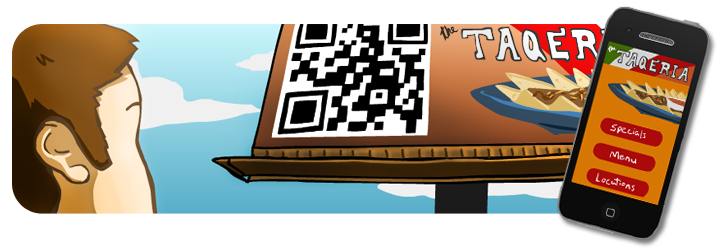For Professional Service: Contact Us
For Professional Service: Contact Us

Posted by Jason Summerfield
QR codes have become an increasingly popular means to fuse print with digital media. While QR codes are relatively easy to generate, their effectiveness is only as good as the strategy and standards that are applied with their use. It is tempting for many marketers to simply slap a QR code into an advertisement or print collateral, point it to the homepage of their website and call it a day. But as with any form of marketing, there are a number of best practices to consider for optimal results.
A QR code is simply a link to a landing page on the mobile web. Rather than thinking of a QR code as an end unto itself, consider how the code can be leveraged to guide visitors to something of interest or value; what will be the benefit for your organization, as well as the person scanning the code? Keeping your larger goals in mind is an important element of a a well-planned QR Code best practices strategy.
QR codes are typically placed in marketing materials, advertising or other print collateral. Ideally, the QR code will send users to a landing page or online resource that is complementary to the printed piece where it appears. For example, an advertisement for a new product could have a QR code that links to a video of a product demonstration and customer testimonials; a flyer for an event promotion could have a QR code that points to a mobile webpage with an event registration form. Conversely, if the QR code leads users to a resource with no clear purpose or relationship to the print material it can create a disconnect that is confusing for the user.
Along with placing the code within a logical context, it's also important to have a clear call-to-action that accompanies the code. People will be more likely to scan your code if you tell them what they can expect from doing so. This can be accomplished by placing a call-to-action adjacent to the code.
There are many calls-to-action that could work effectively with QR codes, such as: “Scan this QR code to [insert compelling reason: e.g. ‘watch a video’, ‘read testimonials’, ‘like us on Facebook’, ‘request information’, ‘call our Help Line’, ‘download a coupon’, ‘place an order’, etc]”.
When someone scans QR code you already know they’re on a smartphone, so it just makes sense that your landing page should be optimized for viewing on a handheld device. If you send users to a “regular” page formatted for standard desktop viewing it not only creates a negative user-experience, but it also reflects poorly upon your organization.
If you do not have a mobile landing page then alternative options are to direct the QR code to your presence on 3rd party sites that offer mobile-friendly viewing options, such as YouTube (if you have video to share) or Facebook, provided it makes sense for the context in which you place the code.
QR Codes are most commonly displayed as a black code on a white background, and with good reason, as this color combination provides the greatest contrast. Contrast is an important factor in scan reliability, so a black code on a white background is the safest display option in terms of color. However, it is also possible to display QR codes in a variety of colors, provided there is sufficient contrast between the foreground (code) and the background. Generally, the darker the color of the code, and the lighter the background, the more reliably the code will scan.
It is also possible to display a QR code in a reversed color pattern (light code on dark background), but this is not advisable, as many QR code readers cannot read the code if it is reversed out on a dark background.
The QR code needs to be of a sufficient size to be scanned reliably; generally, the minimum size of the printed code should be one inch. In determining the size of the code you will also want to take into account the expected distance the user will be from the code when it is scanned. A good rule of thumb is to assume a 1:10 size-to-distance ratio, under ideal conditions. So if the code size is one inch, the user can be up to 10 inches away when the code is scanned. If you anticipate a scenario where users will be standing at a further distance then you will need to increase the size of the code accordingly (e.g. a product display where you anticipate users to be three feet away would call for a code of about 3.5 inches). If you anticipate more challenging conditions such as low-light, or low contrast, then a more conservative 1:8 size-to-distance ratio may be more suitable.
It's generally a good idea to have a margin of empty whitespace around the perimeter of the code (AKA the “quiet zone”), as objects positioned near the edge of the code can interfere with scan reliability. The quiet zone should be equal to at least four of the modules (little squares) within the code.
It's important to think about the literal placement of the code, to ensure that there are no obstructions that could interfere with getting a clean scan. For example, if a code is placed too close to the edge of the fold in a magazine it might be difficult to get the code to scan correctly. If a code is placed on a billboard you would want to make sure there were no wires, branches or other items that would cross the visual path of the code and interfere with scanning.
QR codes can be placed on just about anything that can accept printing, including paper, plastics and fabric, as well as electronic/screen-display. Generally speaking, QR codes should be placed on a flat surface that is not reflective, in order to avoid glare (think matte rather than gloss). Materials that are porous or bumpy are not ideal for QR code presentation.
Consider the environment in which the code will be placed – will it be pretty consistent, or might it change in ways that could affect the scan reliability of the code? For example, can you assume that there will always be sufficient lighting, or will lighting conditions change; is the code on a material that could cause glare in sunlight? Also consider connectivity - since most codes send users to some web-based destination it's also important to ensure that there is a reliable data connection (3G, 4G, WiFi) within the immediate area where the code will be placed.
Ideally, you want to make sure you have a means to track how many scans your code gets over time so that you know how well it is performing. A QR code tracking system can provide you with much of the same data as would be collected from standard web analytics, including total scans vs. unique scans, time, location and device type.
Static QR codes are codes that are created with the landing page URL embedded directly into the code, whereas a dynamic code (also known as a “hosted code”) uses a tracking URL that redirects to the landing page. The benefit of the dynamic code is that it provides the flexibility to change the destination URL/landing page, even after the code has been printed; if you want to change the URL of a static code after it's been printed you’re out of luck. Dynamic codes also tend to allow for shorter URLs, meaning the code needs to hold less data and can therefore scan more reliably at smaller sizes.
It's always a good idea to test your codes for scan reliability on a range of QR code readers, and on multiple device types. If you only test on a limited range of devices/readers you could be overlooking potential issues. It's particularly important to make sure you test finished, press-ready proofs before final publication to ensure you follow QR Code best practices and that there are no stray marks or other variables that could interfere with scanning.

To learn more about how Qfuse can work for your organization, simply complete the form below and we'll be happy to follow-up with additional information, including: